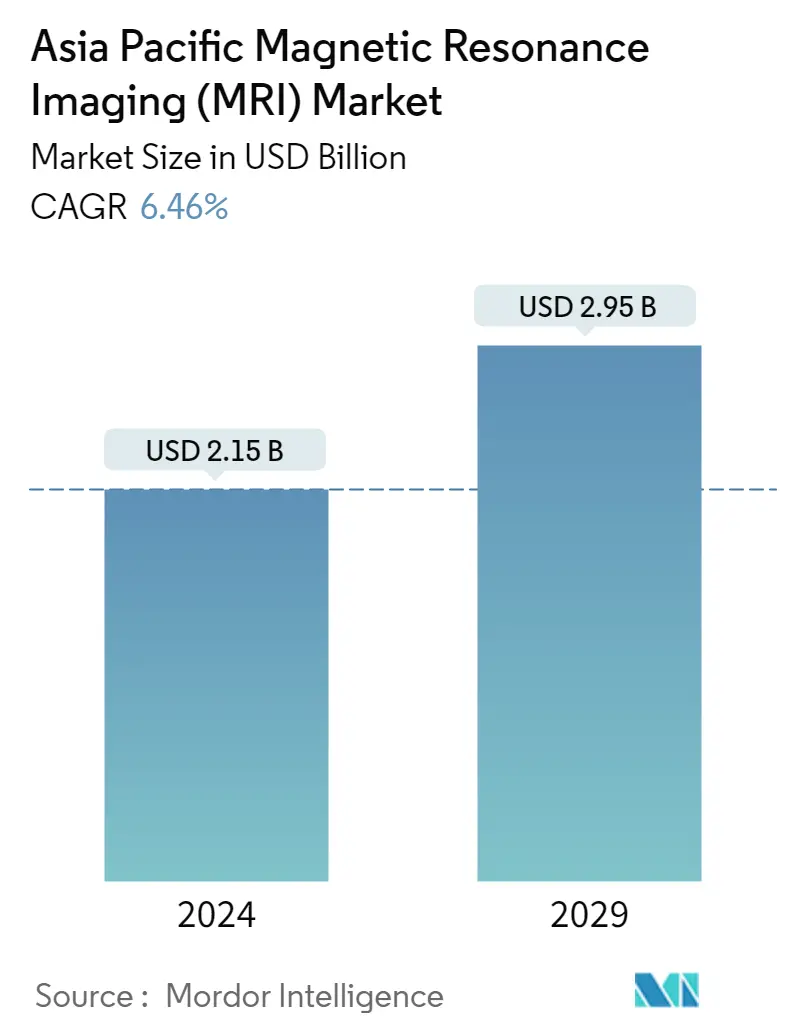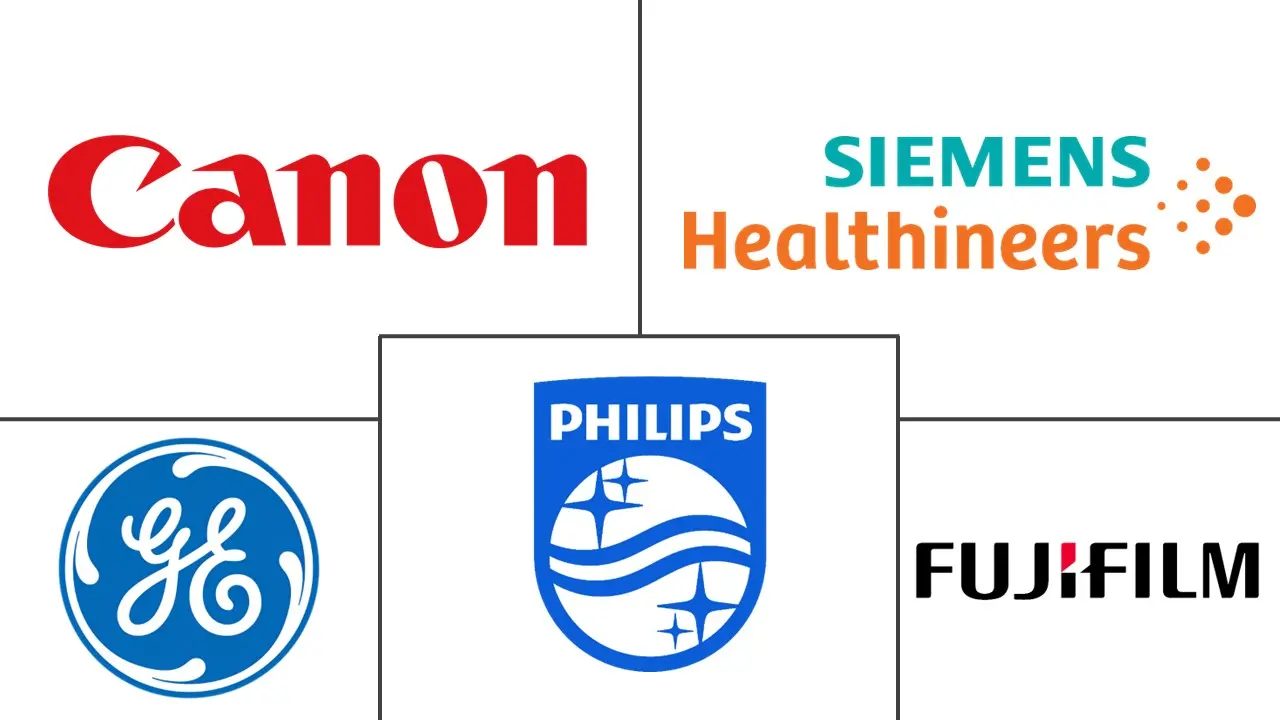Market Size of Asia Pacific Magnetic Resonance Imaging (MRI) Industry

| Study Period | 2019 - 2029 |
| Base Year For Estimation | 2023 |
| Market Size (2024) | USD 2.15 Billion |
| Market Size (2029) | USD 2.95 Billion |
| CAGR (2024 - 2029) | 6.46 % |
| Market Concentration | Medium |
Major Players
*Disclaimer: Major Players sorted in no particular order |
Magnetic Resonance Imaging Market Analysis
The Asia Pacific Magnetic Resonance Imaging Market size is estimated at USD 2.15 billion in 2024, and is expected to reach USD 2.95 billion by 2029, growing at a CAGR of 6.46% during the forecast period (2024-2029).
During the early pandemic, due to lockdown restrictions, suspension of non-urgent scheduled visits and hospitalizations, and stringent social distancing norms, the demand for MRI imaging was reduced, which affected the market studied. As per the article published by the National Institute of Health in January 2021, the radiology services in India were majorly damaged during the COVID-19 pandemic, and hospital systems were largely affected. However, post-pandemic, the market is expected to gain traction over the coming years because of declining COVID-19 cases and the resumption of hospital services and MRI imaging.
The market is driven by the rising prevalence of chronic diseases in the country. With the increasing burden of chronic diseases, such as cancer and cardiovascular diseases, coupled with the technological advancements in the country, the magnetic resonance imaging (MRI) market is expected to grow in the region. For instance, according to the study published in the Chinese Medical Journal in March 2022, in China, there were about 4,820,000 cancer cases and 3,210,000 cancer deaths in 2022. Lung cancer is the most prevalent cancer in China and the leading cause of cancer death. In China, age-standardized incidence and mortality rates have increased. Thus, the country's significant burden of cancer is expected to boost the market over the forecast period.
Additionally, the availability of universal health coverage in several Asian countries is expected to boost market growth over the forecast period. For instance, as per World Bank data published in October 2021, to ensure that their populations can access the healthcare they require without experiencing financial hardship, the World Bank has assisted nations throughout East Asia and the Pacific in their efforts to improve health services. Results-based financing based on disbursement-linked indicators (DLIs) is proving a valuable tool, helping maintain momentum towards universal health coverage (UHC) in the region. East Asian and Pacific Island nations have committed to offering their citizens universal health coverage so they may get the high-quality care they need when they need it without facing financial hardship.
Factors such as the increasing adoption of MRI coupled with initiatives by public and private organizations are expected to increase the market's growth. For instance, in January 2021, Promaxo Inc., the medical imaging, robotics, and AI technology company, and Huami Corp. closed an investment round of USD 4.17 million led by Huami. The Huami Corporation made a strategic investment in Promax, Inc. to develop powerful open MRI systems that provide better healthcare to patients and clinical settings. Similarly, in May 2021, the government of Andhra Pradesh launched CT and MRI scanners in four hospitals located in Ongole, Kadapa, Srikakulam, and Nellore. Therefore, due to the above-mentioned factors, the magnetic resonance market is expected to grow during the forecast period.
Hence, with the above-mentioned factors, it is observed that increasing awareness regarding MRI scans is propelling the growth of the MRI services market across the Asia-Pacific region. However, the high cost of the MRI system may hamper the market growth.
Magnetic Resonance Imaging Industry Segmentation
As per the scope of the report, magnetic resonance imaging is a medical imaging technique that is used in radiology to produce pictures of the anatomy and the physiological processes of the body in both health and disease. These pictures are further used to diagnose and detect the presence of abnormalities in the body. The Asia-Pacific Magnetic Resonance Imaging (MRI) Market is Segmented by Architecture (Closed MRI Systems and Open MRI Systems), Field Strength (Low Field MRI Systems, High Field MRI Systems, and Very High Field MRI Systems and Ultra-high MRI Systems), Application (Oncology, Neurology, Cardiology, Gastroenterology, Musculoskeletal, and Other Applications), and Geography (China, Japan, India, Australia, South Korea, and Rest of Asia-Pacific). The report offers the value (in USD million) for the above segments.
| By Architecture | |
| Closed MRI Systems | |
| Open MRI Systems |
| By Field Strength | |
| Low Field MRI Systems | |
| High Field MRI Systems | |
| Very High Field MRI Systems and Ultra-high MRI Systems |
| By Application | |
| Oncology | |
| Neurology | |
| Cardiology | |
| Gastroenterology | |
| Musculoskeletal | |
| Other Applications |
| Geography | |
| China | |
| Japan | |
| India | |
| Australia | |
| South Korea | |
| Rest of Asia-Pacific |
Asia Pacific Magnetic Resonance Imaging (MRI) Market Size Summary
The Asia-Pacific MRI market is poised for significant growth over the forecast period, driven by the increasing prevalence of chronic diseases such as cancer and cardiovascular conditions, alongside technological advancements in imaging systems. The market experienced a temporary setback during the early pandemic due to reduced demand for non-urgent medical services, but it is expected to recover as healthcare services resume and COVID-19 cases decline. The availability of universal health coverage in several Asian countries is also anticipated to bolster market expansion, enabling broader access to MRI services without financial hardship. Additionally, strategic investments and collaborations among key players, such as Promaxo Inc. and Huami Corp., are fostering innovation in MRI technology, further propelling market growth.
The competitive landscape of the Asia-Pacific MRI market is characterized by the presence of major players like Siemens Healthcare, GE Healthcare, and Canon Medical Systems Corporation, who are continually introducing advanced MRI systems with enhanced capabilities. Product launches, such as Siemens' MAGNETOM Altea and Neusoft Medical's NeuMR Libra, are contributing to market dynamics by offering cutting-edge solutions powered by artificial intelligence. Despite the high cost of MRI systems posing a potential challenge, the increasing awareness and demand for MRI scans, particularly for neurological disorders like dementia, are expected to drive market growth. The market's expansion is further supported by initiatives from both public and private sectors, aiming to improve healthcare infrastructure and services across the region.
Asia Pacific Magnetic Resonance Imaging (MRI) Market Size - Table of Contents
-
1. MARKET DYNAMICS
-
1.1 Market Overview
-
1.2 Market Drivers
-
1.2.1 Increasing Burden of Chronic Diseases
-
1.2.2 Availability of Universal Health Coverage in Several Asian Countries
-
1.2.3 Introduction of Hybrid MRI Systems & Increasing Adoption in Emerging Asian Markets
-
-
1.3 Market Restraints
-
1.3.1 High Cost of MRI Systems
-
1.3.2 Declining Helium Availability
-
-
1.4 Porter Five Forces
-
1.4.1 Threat of New Entrants
-
1.4.2 Bargaining Power of Buyers/Consumers
-
1.4.3 Bargaining Power of Suppliers
-
1.4.4 Threat of Substitute Products
-
1.4.5 Intensity of Competitive Rivalry
-
-
-
2. MARKET SEGMENTATION (Market Size by Value - USD million)
-
2.1 By Architecture
-
2.1.1 Closed MRI Systems
-
2.1.2 Open MRI Systems
-
-
2.2 By Field Strength
-
2.2.1 Low Field MRI Systems
-
2.2.2 High Field MRI Systems
-
2.2.3 Very High Field MRI Systems and Ultra-high MRI Systems
-
-
2.3 By Application
-
2.3.1 Oncology
-
2.3.2 Neurology
-
2.3.3 Cardiology
-
2.3.4 Gastroenterology
-
2.3.5 Musculoskeletal
-
2.3.6 Other Applications
-
-
2.4 Geography
-
2.4.1 China
-
2.4.2 Japan
-
2.4.3 India
-
2.4.4 Australia
-
2.4.5 South Korea
-
2.4.6 Rest of Asia-Pacific
-
-
Asia Pacific Magnetic Resonance Imaging (MRI) Market Size FAQs
How big is the Asia Pacific Magnetic Resonance Imaging (MRI) Market?
The Asia Pacific Magnetic Resonance Imaging (MRI) Market size is expected to reach USD 2.15 billion in 2024 and grow at a CAGR of 6.46% to reach USD 2.95 billion by 2029.
What is the current Asia Pacific Magnetic Resonance Imaging (MRI) Market size?
In 2024, the Asia Pacific Magnetic Resonance Imaging (MRI) Market size is expected to reach USD 2.15 billion.

